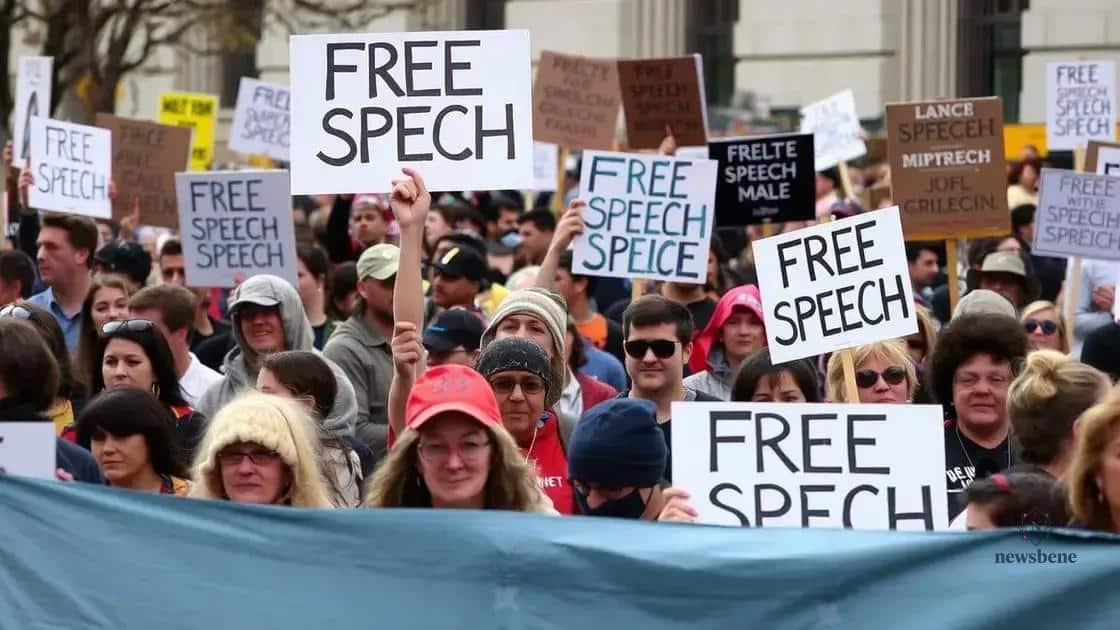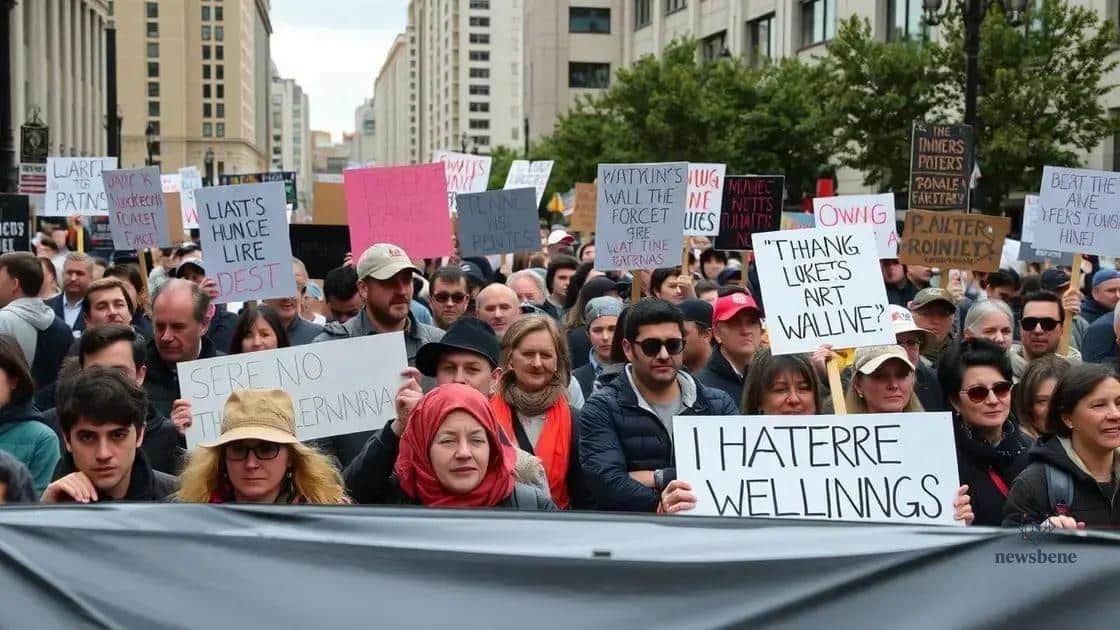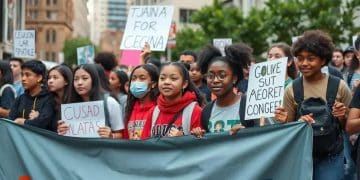Legal battles over free speech demonstrations: what you need to know

Legal battles over free speech demonstrations address the complexities of expressing opinions publicly while navigating legal restrictions, social media challenges, and the societal impact on democracy.
Legal battles over free speech demonstrations often ignite heated debates about rights and responsibilities. Have you ever wondered how these conflicts can shape our understanding of democracy? In this article, we delve into the complexities behind these legal skirmishes.
Understanding free speech rights
Understanding free speech rights is crucial in today’s world. These rights allow individuals to express their thoughts and opinions without fear of government censorship. In this section, we will explore what free speech really means and its implications in society.
What Are Free Speech Rights?
Free speech rights are protected under the First Amendment of the U.S. Constitution. This amendment ensures that citizens can voice their ideas freely, whether they are popular or controversial. However, these rights are not absolute.
Limits on Free Speech
While individuals have the right to speak their minds, there are certain restrictions in place.
- Speech that incites violence or causes panic is not protected.
- Defamation and hate speech can also lead to legal consequences.
- Obscenity, which does not adhere to societal norms, is often regulated.
- Commercial speech is subject to scrutiny as well.
This highlights the balance society must strike between allowing freedom of expression and protecting individuals from harm.
Various court cases have shaped our understanding of free speech rights over the years. Landmark rulings help clarify where the line is drawn between permissible expression and harmful speech. It’s essential to stay informed about how these rulings might impact personal expression.
Moreover, understanding the context of free speech is vital. Social movements often challenge these rights to bring about change. Protesters rally and take to the streets, exercising their right to demonstrate for causes they believe in. This active engagement in civic matters underscores the importance of free speech in a democratic society.
With an evolving legal landscape, ongoing debates surrounding free speech rights continue to challenge the status quo. Staying informed about laws and their implications can empower individuals to engage more actively in public discourse.
Key legal cases shaping free speech
Key legal cases have profoundly shaped free speech rights in the United States. These cases demonstrate how the law interprets the limits of expression and the consequences of speech. Understanding these landmark rulings is essential for grasping the current landscape of free speech.
Landmark Cases
One significant case is Schenck v. United States (1919). This ruling established the “clear and present danger” test. It determined that speech could be limited if it poses a significant threat to national security.
Another crucial case, Tinker v. Des Moines Independent Community School District (1969), highlighted students’ rights to express their opinions in schools. The Supreme Court ruled that students do not lose their right to free speech at school, as long as it does not disrupt the educational process.
- New York Times Co. v. United States (1971) emphasized the protection of press freedom.
- Brandenburg v. Ohio (1969) refined the limits of free speech by protecting inflammatory speech as long as it does not incite imminent lawless action.
- Texas v. Johnson (1989) affirmed the right to burn the American flag as a form of political expression.
The implications of these cases extend beyond legal principles; they influence societal norms and the public’s understanding of what constitutes free speech. As more cases arise, the judicial system continues to adapt to challenges concerning expressions, especially in the digital age.
Modern issues surrounding hate speech and online expression are now being tested in courts. These legal battles will likely define the future of free speech as they challenge existing norms and balance rights with societal interests. Staying informed about these developments is vital for advocates and citizens alike.
The role of demonstrations in society

The role of demonstrations in society is vital for expressing opinions and advocating for change. These collective activities enable citizens to showcase their beliefs and demand action on various issues. From civil rights to environmental causes, demonstrations have historically played a crucial part in shaping public policy.
Historical Importance
Demonstrations have a rich history, often serving as a catalyst for significant social changes. For example, the civil rights movement in the 1960s showcased peaceful protests that were pivotal in achieving landmark legislative reforms.
Forms of Demonstrations
There are many types of demonstrations, each with its own purpose and style. Some common forms include:
- Marches bring people together to walk in unison toward a common goal.
- Rallies typically gather supporters in a specific location to listen to speakers and unite the cause.
- Vigils are peaceful gatherings that honor victims or raise awareness about specific issues.
- Protests express dissent against policies or actions deemed inappropriate by participants.
These activities foster a sense of community and encourage public dialogue. Through their participation, individuals can influence those in power and raise awareness on critical issues. Notably, social media has expanded the reach of demonstrations, allowing for quick mobilization and global attention.
Importantly, while demonstrations can stir positive change, they also face challenges. Legal restrictions and pushback from authorities can complicate peaceful assembly. Understanding the rights associated with demonstrations is essential for participants to effectively advocate for their causes.
Overall, the role of demonstrations extends beyond mere expression; they are a form of activism that can lead to meaningful societal shifts. The continued participation of individuals in demonstrations illustrates a vibrant civic engagement.
Challenges faced by protesters
Protesters often encounter various challenges when fighting for their beliefs. These obstacles can hinder their ability to express themselves and advocate for changes in society. Understanding these challenges is vital for anyone interested in social movements.
Legal Hurdles
One major challenge is navigating the legal system. Protesters must be aware of local laws regarding public assembly. In some areas, permits are required to hold demonstrations, which can complicate planning.
Police Response
Another significant issue is the police response to protests. Law enforcement may employ tactics such as crowd control or even use of force to manage large gatherings. This can lead to tensions between protesters and police, sometimes resulting in violence.
- Excessive force can escalate situations unexpectedly.
- Arrests during protests can deter participation.
- Surveillance of protesters raises privacy concerns.
Such responses can discourage individuals from joining movements out of fear for their safety or legal repercussions. Sadly, these fears often deter public activism and silence important voices.
Additionally, protesters face the challenge of public perception. Media coverage can shape how movements are viewed. Misrepresentation or bias in reporting may skew public understanding of the protest’s purpose and goals. This can lead to misconceptions about the movement and its supporters.
Moreover, counter-protests can create hostile environments. When groups opposing the cause show up, tensions can rise. It is essential for protesters to prepare for these situations, ensuring safety and clarity of their message amidst the chaos.
Finally, internal challenges can arise within movements themselves. Disagreements among members can lead to fractures in solidarity. Communication and unity are key to overcoming these hurdles and ensuring the movement’s message remains strong.
Potential future of free speech laws
The potential future of free speech laws is a topic of significant debate. As technology evolves, new challenges arise that complicate traditional understandings of free speech. Social media platforms and instant communication have changed how information is shared and consumed.
Impact of Technology
Online platforms can facilitate both free expression and the spread of misinformation. This duality raises complex questions about the extent to which tech companies should regulate speech. Should these platforms intervene to remove harmful content, or do they risk limiting free expression?
Legal Reforms
In response to these challenges, lawmakers may consider reforms to existing free speech laws. Potential changes could include:
- Updating definitions of what constitutes protected speech, especially concerning online expression.
- Clarifying the responsibilities of social media companies regarding harmful content.
- Implementing stricter regulations against hate speech while balancing the right to free expression.
As society grapples with these issues, public opinion plays a crucial role. Citizens and activists will likely advocate for changes that reflect new societal values. The ongoing discussions about how to balance free speech with community safety will shape future laws.
Moreover, global perspectives on free speech may influence domestic laws. As countries around the world face similar issues, sharing insights and experiences could lead to significant legal changes. This international dialogue could help establish norms that respect free expression while addressing the rise of digital platforms.
Finally, it’s essential for future legal frameworks to ensure that they adapt to the changing landscape of communication. Continuous engagement from citizens will be key in shaping laws that promote both freedom and responsibility. In essence, the future of free speech laws will depend on our collective ability to navigate the complexities of a digital age.
FAQ – Frequently Asked Questions about Free Speech Law
What is free speech?
Free speech is the right to express one’s opinions and ideas without fear of government censorship or punishment.
Are there limits to free speech?
Yes, free speech is not absolute. Limitations include restrictions on hate speech, defamation, and incitement to violence.
How do technology and social media affect free speech?
Technology provides new platforms for expression but also raises challenges related to misinformation and content moderation.
What role do protests play in advocating for free speech?
Protests are a powerful way for citizens to unite and express their views, influencing public opinion and policy changes.






